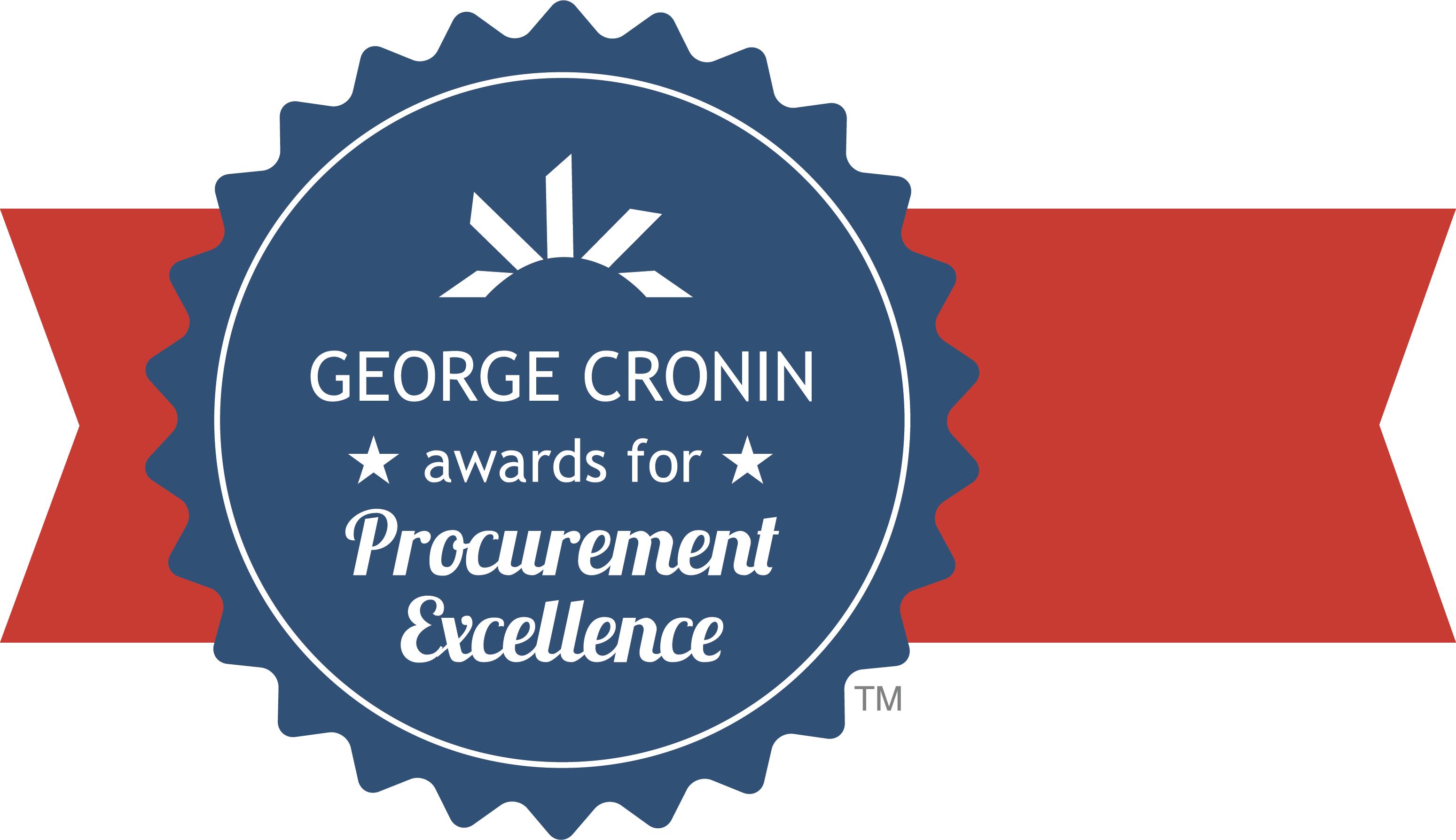
The Cronin Award is intended to serve two purposes. First, of course, it seeks to recognize outstanding state procurement initiatives—providing some well-deserved appreciation to a State and its procurement personnel that have undertaken and accomplished projects that result in distinct benefits to the State in economy, efficiency, delivery of services or some combination of each.
Second, by calling attention to these efforts, the Cronin Award serves as a means to disseminate and to encourage adoption of these initiatives by other States. In this way, Cronin awardees and finalists create opportunities for improving the procurement function nationwide, which can multiply those initial benefits many times over.
Please note: Nominations for the George Cronin Awards for Procurement Excellence are intended for state central procurement offices, and must be submitted by, or with approval from, the NASPO voting member (CPO) within your state. If you have questions about who can submit for the award, please contact Chadwick Stephens at [email protected]
The submission template provides guidelines that will help you build a strong submission. The evaluation of the Cronin Awards consists of four categories, each one examining a different aspect of the project’s impact and each weighed separately to provide an overall score (more details available in the subsections below). Submissions are limited to four pages, although optional supporting material can also be submitted as a separate document when needed to showcase images, examples, or documentation that is too large to fit within the four-page submission itself. Supporting materials should do just that—support and document the statements made and results described in the submission itself.

to download the new submission template and get started on your nomination!
Submissions are closed for the 2023 Awards.

Introduction to Submission / Executive Summary
It is useful to committee members for a submission to begin with a short executive summary/introduction that describes the purpose and scope of the project and gives a brief overview of the implementation process. The introduction should also include a summary statement of the content of each of the four categories and a comment on the results of the project. If there is anything in the submission to which committee members should pay particular attention, it is helpful to mention it in the introduction. This executive summary should not exceed one page and is included as part of the total pages for the submission.
Below are the categories you should ensure are covered within your four page nomination. Using the template above will make this a lot easier.

Scoring Categories

Innovation
(30 points) – Unusual or unique approach, scale, or magnitude of effort; conceptual originality. This category should answer the question, “What makes this project stand out as a notable contribution to the procurement function?” It is intended to capture the nature and impact of changes in your state operations, but it also rewards path-breaking ideas or efforts that may not have been considered or attempted elsewhere. Because substantial originality is so rare, this category offers the highest potential point total to a submission that is able to point out differences and to distinguish itself from closely similar projects completed or underway in other states.

Transferability
(30 points) – Primarily an external focus that assesses the practical ability by other states to replicate or use as a benchmark, considering expected resources required and generality of the legal or structural environment in which the entry was implemented. A project or initiative that can be used broadly by other states as a template will receive a higher score than one with benefits that appear to depend on the particular geography, environment, governmental structure or particular needs of the submitting state. In some cases, it may be necessary to explain how an apparent state-bound effort can be adapted for greater transferability.

Service Improvement
(25 points) – An internal focus that assesses the extent to which transactions or service delivery is made more effective; includes consideration of nature of stakeholder involvement by agencies/users in development & implementation of program or project; change management strategy sufficient to promote adoption. Every purchasing organization provides a service to other state agencies, and this category is intended to assess results—the impact of the project on improving the delivery of those services. More weight is given to specifics than to generalities. When metrics are provided, it is beneficial to include a short (non-technical) explanation of how those metrics were produced. Also, committee members look favorably on descriptions of the input, participation and adoption by stakeholders.

Cost Reduction
(15 points) – Validated or potential for cost reduction, including considerations of efficiency. Although cost reduction may not be quite as highly weighted as the other three categories, well-documented estimates or projections of savings is often the determining factor between otherwise generally equal submissions. Cost savings figures are given more weight when they are objective and include an explanation of how they were derived. Although increases in efficiency are less open to precise calculation, the manner or method by which the increase is realized should be described. In general, undocumented claims of very large cost reductions are less likely to receive higher scores than smaller, but significant and well-supported cost savings estimates.
Resubmissions
Resubmittal of past nominations is allowed, however it must meet the following criteria:
- The resubmittal cannot have received any level of Cronin award (e.g., Gold, Silver or Bronze) from a past year
- The resubmittal must contain new information from the previous submission
- The resubmittal must clearly describe the significant changes/circumstances that make this program viable for resubmission
The Cronin Awards Committee will review the resubmission justifications to determine whether the submission will be included with those to be scored. If the committee determines the reasons for resubmission are substantial, then the entire document will be reviewed along with the other submissions. If, however, the committee determines, based on the justification, that a particular resubmittal does not merit inclusion in the group to be scored, the resubmittal will not be scored. All states involved with a resubmittal will be notified of the committee’s decision to include or exclude their submission from scoring immediately following the committee’s decision.
History of the Cronin Awards
George J. Cronin was the State Purchasing Agent for the Commonwealth of Massachusetts from 1925 to 1957, serving under 11 different governors. He was known as a trail blazer in the public procurement field and established the ground rules and operative procedures for centralized procurement within the Commonwealth. He was the first president of NASPO and is the namesake of the NASPO Cronin Club and the annual George Cronin Award for Procurement Excellence.
NASPO was founded in 1947 at a meeting of state purchasing officials in Chicago, Illinois. The meeting was originally designed to seek ways and means for states to secure property distributed under the Surplus War Property Disposal Act of 1944. While at the meeting, Cronin urged the formation of an ongoing, formal organization of state purchasing officials as an effective vehicle to address specific public procurement issues and provide a network for resolving problems. The other attendees agreed and elected Cronin as president. He remained active in NASPO activities after his retirement in 1957.
The Cronin Club evolved from an idea presented by John Dyer of Maine to form an organization of NASPO past presidents and name it after Mr. Cronin. The group met for the first Cronin Club Luncheon at the NASPO Annual Conference in 1970. In 1974, the Cronin Club opened the luncheon to any NASPO member who wished to participate instead of restricting attendance to the past presidents and it became an established feature of the NASPO Annual Conference.
The Cronin Club decided to sponsor a “cost reduction” incentive program in 1977. This created interest among the states and encouraged them to share cost saving ideas with other states. The program has evolved over the past 30 years and adapted to the changing procurement landscape. The George Cronin Award for Procurement Excellence is recognized as a premier achievement for innovative public procurement and pays homage to a founder and the first president of NASPO for his devotion to improving governmental purchasing.
The 2022 George Cronin Awards for Procurement Excellence were announced at NASPO’s Annual Conference, held in San Diego, California, September 25th-28th.
As an overview of these now award-winning projects, NASPO produced a short video on each submission.
Winners
Gold Winner

Michigan – Competitive Proof of Concept: Trying Before You Buy While Complying with Competitive Requirements
Silver Winner
Bronze Winner
 Tennessee – Diversity Intelligence in Tennessee-II (DIT-II)
Tennessee – Diversity Intelligence in Tennessee-II (DIT-II)Finalist
 Minnesota – The Right Step
Minnesota – The Right StepFinalist
 Georgia – Procurement Officer Boot Camp
Georgia – Procurement Officer Boot Camp
To view any of the full 2022 submissions, click here.
The 2021 George Cronin Awards for Procurement Excellence were announced at NASPO’s Annual Conference, held in Austin, Texas, September 15th-17th.
As an overview of these now award-winning projects, NASPO produced a short video on each submission.
-
Gold Winner
-
Silver Winner
-
Bronze Winner
-
Finalist
-
Finalist
To view any of the full 2021 submissions, click here.
Due to the Coronavirus Pandemic the 2020 Cronin Committee suspended the 2020 George Cronin Awards for Procurement Excellence. In its place, the Committee aimed to highlight the enormous response efforts undertaken by the state procurement offices across the country. Named Pandemic Procurement Excellence (PPE), the alternate project gave procurement officials a platform to share their stories of pandemic procurement.
2019
-
-
- Gold Award Winner: State of Michigan, Circumventing Risk with Contract Management
- Silver Award Winner: State of Florida, Market Analysis and Procurement Strategy
- Bronze Award Winner: State of Minnesota, Innovation Begets Innovation: How Challenge-Based RFP’s Have Been a Winning Solution for Minnesota
- Finalist: Commonwealth of Massachusetts, Excellent Data = Meaningful Analytics: Improving Vendor Report Information Management
- Finalist: State of New York, Online File Requirements System
-
2018
-
-
- Gold Award Winner, State of Alaska, Continuous Improvement in Statewide Procurement
- Silver Award Winner, State of Massachusetts, Local Government Enablement (LGE) team
- Bronze Award Winner, State of Michigan, The Unrealized Transformative Power of Internally-Focused KPI’s in Public Procurement
- Finalist, State of Pennsylvania, Pennsylvania Best Value Initiative
- Finalist, State of Oklahoma, Innovate OK: The Market of Government Innovation
-
2017
-
-
- Gold Award Winner, State of Utah, ValuePoint Cloud Solutions Procurement
- Silver Award Winner, State of New York, IT Based Umbrella Contracts
- Bronze Award Winner, State of Tennessee, Collaborative Value Development
- Finalist, State of Georgia, Amazon Business Marketplace
- Finalist, State of Florida, Concierge Service for Contract Education
- Cronin Heritage Award, Commonwealth of Virginia, eVA Mobile Apps – View Webinar
-
2016
-
-
- Gold Award Winner, State of Tennessee: Radio Equipment and Services – View Webinar
- Silver Award Winner, State of Wisconsin: IT Procurement Best Practices Playbook – View Webinar
- Bronze Award Winner, Commonwealth of Massachusetts: FAC85: Environmentally Preferable Cleaning Products, Programs, Equipment and Supplies – View Webinar
- Finalist, State of Wisconsin: Professional Development in Negotiation Skills on Behalf of a State – View Webinar
- Finalist, State of New Jersey: NJSTART – View Webinar
-
2015
-
-
- Gold Award Winner, State of Tennessee: Tourist Development – Marketing and Advertising – View Webinar
- Silver Award Winner, State of Minnesota: Minnesota’s MMCAP Focus Data Analytics System – View Webinar
- Bronze Award Winner, State of New York: New York State Vehicle Marketplace – View Webinar
- Finalist, State of Ohio: Ohio Waste Management Program – View Webinar
- Finalist, State of Delaware: Maximizing Fleet Resources and Streamlining Operations – View Webinar
-
2014
-
-
- 2014 George Cronin Award for Procurement Excellence, Gold: Virginia, eVA Mobile Apps – View Webinar
- 2014 George Cronin Award for Procurement Excellence, Silver: California, Modeling the Path to Award – View Webinar
- 2014 George Cronin Award for Procurement Excellence, Bronze: Tennessee, Innovations in Facilities Management – View Webinar
- 2014 George Cronin Award for Procurement Excellence, Finalist: Delaware, Copier, Printer and Multifunction Device Resource Management Program – View Webinar
- 2014 George Cronin Award for Procurement Excellence, Finalist: Tennessee, Vehicle Fleet Management – View webinar
-
2013
-
-
- 2013 George Cronin Award for Procurement Excellence, Gold: Mississippi, Mississipi Procurement Transformation: Driving Efficiency into Business Operations – View Webinar
- 2013 George Cronin Award for Procurement Excellence, Silver: Oklahoma, Multi-State Natural Gas Vehicles OEM Contract – View Webinar
- 2013 George Cronin Award for Procurement Excellence, Bronze: New York, Hourly Based IT Services – View Webinar
- 2013 George Cronin Award for Procurement Excellence, Finalist: Oregon, Groceries: “Indefinite Delivery Contracts Provide Real Savings to Small Agencies” –View Webinar
-
2012
-
-
- 2012 George Cronin Award for Procurement Excellence, Gold: Oregon, Statewide Fleet Program, ‘Direct Dealership Price Agreements’ – View Webinar
- 2012 George Cronin Award for Procurement Excellence, Silver: Texas, TEX-AN Next Generation Procurement – View Webinar
- 2012 George Cronin Award for Procurment Excellence, Bronze: Arizona, Driving State Procurement Decisions Using Business Intelligence – View Webinar
- 2012 George Cronin Award for Procurement Excellence, Finalist: Massachusetts,Massachusetts Procurement Reforms – View Webinar
- 2012 George Cronin Award for Procurement Excellence, Finalist: Indiana, K12 Indiana – View Webinar
-
2011
-
-
- 2011 George Cronin Award for Procurement Excellence, Gold: Oregon, Nationwide Lodging Services: State of Oregon/WSCA Lodging Program
- 2011 George Cronin Award for Procurement Excellence, Silver: Idaho, Best Value Performance Information Procurement System
- 2011 George Cronin Award for Procurement Excellence, Bronze: Oregon, Disaster Response Procurement
- 2011 George Cronin Award for Procurement Excellence, Finalist: Arizona – ProcureAZ (Finalist)
-
2010
-
-
- 2010 George Cronin Award for Procurement Excellence, Gold: Minnesota & Wisconsin, Partnership Initiative
- 2010 George Cronin Award for Procurement Excellence, Silver: Georgia, State Purchasing Division’s SUM (Spend Under Management) Initiative
- 2010 George Cronin Award for Procurement Excellence, Bronze: Ohio, Local Print Consolidation Program
-
2009
-
-
- 2009 George Cronin Award for Procurement Excellence, Gold: Oregon, Information Technology Managed Service Provider (IT MSP) for Hourly and Project Based Services
- 2009 George Cronin Award for Procurement Excellence, Silver: Pennsylvania, Energy Strategy
- 2009 George Cronin Award for Procurement Excellence, Bronze: New York, NYS OGS PSG – Natural Gas Contract
-
2008
-
-
- 2008 George Cronin Award for Procurement Excellence, Gold: Ohio, Multi-State Procurement of Unique Services
- 2008 George Cronin Award for Procurement Excellence, Silver: District of Columbia, Use of a Wiki for Procuring Goods and Services
- 2008 George Cronin Award for Procurement Excellence, Bronze: Washington, Contract Adoption Rate
-
2007
-
-
- 2007 George Cronin Award for Procurement Excellence, Gold: Minnesota Spend Analysis System
- 2007 George Cronin Award for Procurement Excellence, Silver: District of Columbia Surplus Property Disposal
- 2007 George Cronin Award for Procurement Excellence, Bronze: Georgia Procurement Transformation Initiative
-
2006
-
-
- 2006 Cronin Club Classic Gold: New York Hazardous Incident Response Equipment (HIRE)
- 2006 Cronin Club Classic Silver: Rhode Island Fiscal Fitness Initiative
- 2006 Cronin Club IT Gold: Hawaii Compliance Express Program
-
2005
-
-
- 2005 Cronin Classic Gold: Massachusetts Envirocalc: Environmental Benefits & Energy Cost Savings Calculator for Purchasers
- 2005 Cronin Classic Silver: Michigan MiDEAL Program: Michigan Delivering Extended Agreements Locally
- 2005 Cronin Classic Bronze: New York Aggregated IT Procurement Program
- 2005 Cronin IT Gold: Washington WEBS:Washington Electronic Business Solution
- 2005 Cronin IT Silver: Illinois Knowledge Management System
- 2005 Cronin IT Bronze: New York Road Salt
-
2004
-
-
- 2004 Cronin Classic: Illinois Transformation of Procurment Performance
- 2004 Cronin IT: Arizona SPIRIT: Automated eProcurement System
-
2003
-
-
- 2003 Cronin Classic: Connecticut Weekly Information Newsletter
- 2003 Cronin IT: Virginia eVA Electronic Procurement Solution
-
1985-2002
-
-
- 2002: Alaska Long Distance Learning
- 2001: Idaho Purchasing Modernization Initiative
- 2000: Utah Vehicle Purchase Program
- 1999: Ohio Natural Gas Purchasing Program
- 1998: Missouri PC Prime Vendor Contract
- 1997: Wisconsin Advantis Credit Bureau Access Program
- 1996: North Carolina Micro-Computer & Peripherals Contract as Developed and Managed on the Internet
- 1995: none selected
- 1994: none selected
- 1993: Minnesota Document management system
- 1992: Oregon Vendor information program
- 1991: Arizona Contract for abatement of underground storage tanks
- 1990: New York Contract for electronic ballasts
- 1989: Missouri Pharmacy service contract for correctional facilities
- 1988: Kansas Freight management systems
- 1987: West Virginia Natural gas contract
- 1986: Alaska Video – “A Better Way To Buy”
- 1985: Missouri Competitive bidding of residential rehabilitation services
-






 Idaho –
Idaho – 

